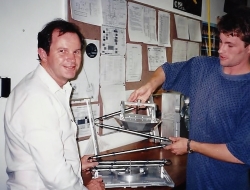Commemorating a 24-year legacy of the launch of SunSat-1
The South African National Space Agency (SANSA) commemorates 24 years since the launch of the first South African satellite SunSat-1 into space. 23 February 1999 marked a historic moment as SunSat-1, first satellite of its kind on the African continent, launched into space aboard a Delta II rocket from the Vandenberg Air Force Base.

South Africa made history by becoming the first African nation to successfully launch an African made satellite into space. This achievement marked a major milestone in the country's space programme and solidified South Africa's position as a leader in the African space industry.
Dan Matsapola, SANSA Science Engagement Manager says “Until the Sunsat-1 launch, South Africa was primarily a supporter of other nations’ space missions and net importer & consumer of space technologies developed elsewhere. Sunsat-1 did not only usher in the pioneering research work done at universities, however, the spinning-off of private companies that have revolutionised the South African space industry. Little girls in black township high schools in 1999 are now space agency Board Members and multi-award winning CEOs of innovative space companies”.
SANSA as an entity of the Department of Science and Innovation (DSI) celebrates this achievement and declares February as National Space-Faring month.
The success of SunSat-1 has inspired a legacy that continues to this day with the recent launch of cubesats, ZACubeSat-1 and ZACubeSat-2 on 21 November 2013 and 27 Dec 2018 respectfully, the South African Maritime Domain Awareness Satellite constellation (MDASat-1) on 13 January 2022 with another three cube satellites planned.
This satellite offered opportunities for local schools to perform experiments in space, such as an experiment from Rhenish Girls High School in Stellenbosch that aimed to monitor radiation damage to Complementary Metal-Oxide-Semiconductor (CMOS) electronics equipment to quantitate the effect of radiation on various circuit boards. The George Campbell Technical High School from Durban, came up with an experiment that contained a sensitive microphone to acquire vibrations in the structure of the satellite in order to aid the ground team to monitor the deployment of the gradient boom.
“Sunsat-1 catapulted South Africa into a technology jump from large to micro sized satellites (at that stage unique in the world). The success and experiences of this satellite paved a way for other South African satellites such as the microsatellite SumbandilaSat, CubeSats ZACube-1 and ZACube2, and other internationally exported satellites and components using the home grown South African engineering ingenuity.
The satellite was a product of many years of research and development to address the technology gap that existed in the market. The data developed from this satellite helped produce numerous student graduates and thus contributed to the thriving space industry in South Africa,” says SANSA Acting Portfolio Management Executive Hendrik Burger.
The SunSat-1 legacy endures as SANSA the Agency continues to provide state-of-the-art facilities that provide 24hour space weather centre (first of its kind in Africa), international space launch and mission support with the development of a new Deep Space network infrastructure in partnership with NASA, extensive data portfolio, products ad services in Earth Observation with a view of expanding space infrastructure to benefit South Africa and the continent.















